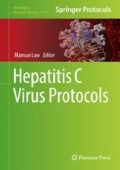Abstract
Experimental characterization of the properties of authentic viruses circulating in infected individuals presents a problem when investigating RNA viruses with error-prone polymerases. The hepatitis C virus provides an extreme example of RNA virus genetic variability, as the nucleotide composition of HCV genomes can vary by more than 30% between strains. The envelope glycoproteins E1 and E2 in particular are able to tolerate a particularly high level of variation. They are under continual selection pressure from the host antibody response during chronic infection and can tolerate adaptive mutations, leading to great diversity in a single host. The diversity of E1/E2 in circulating viruses has hindered investigations of their function and development of a vaccine that will generate antibodies able to potently neutralize entry of genetically distinct strains.
Here we describe methods used in our laboratory to overcome the limitations of investigating the properties of the envelope glycoproteins representing only small numbers of HCV variants. Using a high-fidelity, limiting dilution (“endpoint”) PCR approach to amplify single E1/E2 cDNA templates, which can then generate recombinant model viral particles using retrovirus packaging/reporter constructs. These retroviral pseudoparticles (pseudotypes) facilitate investigation of the properties of authentic E1/E2 glycoproteins in a single-round infection assay. We also describe optimized methods for generation of infectious pseudoparticles from patient-isolated E1/E2 and methods for performing neutralization assays with both anti-virus and anti-host antibodies.
Access this chapter
Tax calculation will be finalised at checkout
Purchases are for personal use only
References
Ramratnam B, Bonhoeffer S, Binley J, Hurley A, Zhang L, Mittler JE et al (1999) Rapid production and clearance of HIV-1 and hepatitis C virus assessed by large volume plasma apheresis. Lancet 354:1782–1785
Smith DB, Bukh J, Kuiken C, Muerhoff AS, Rice CM, Stapleton JT et al (2014) Expanded classification of hepatitis C virus into 7 genotypes and 67 subtypes: updated criteria and genotype assignment web resource. Hepatology 59:318–327
Lindenbach BD, Rice CM (2013) The ins and outs of hepatitis C virus entry and assembly. Nat Rev Microbiol 11:688–700
Bartosch B, Dubuisson J, Cosset FL (2003) Infectious hepatitis C virus pseudo-particles containing functional E1-E2 envelope protein complexes. J Exp Med 197:633–642
Lindenbach BD, Evans MJ, Syder AJ, Wolk B, Tellinghuisen TL, Liu CC et al (2005) Complete replication of hepatitis C virus in cell culture. Science 309:623–626
Lavillette D, Tarr AW, Voisset C, Donot P, Bartosch B, Bain C et al (2005) Characterization of host-range and cell entry properties of the major genotypes and subtypes of hepatitis C virus. Hepatology 41:265–274
Tarr AW, Khera T, Hueging K, Sheldon J, Steinmann E, Pietschmann T et al (2015) Genetic diversity underlying the envelope glycoproteins of hepatitis C virus: structural and functional consequences and the implications for vaccine design. Viruses 7:3995–4046
Urbanowicz RA, McClure CP, Brown RJ, Tsoleridis T, Persson MA, Krey T et al (2016) A diverse panel of hepatitis C virus glycoproteins for use in vaccine research reveals extremes of monoclonal antibody neutralization resistance. J Virol 90:3288–3301
Tarr AW, Owsianka AM, Szwejk A, Ball JK, Patel AH (2007) Cloning, expression, and functional analysis of patient-derived hepatitis C virus glycoproteins. Methods Mol Biol 379:177–197
Owsianka A, Clayton RF, Loomis-Price LD, McKeating JA, Patel AH (2001) Functional analysis of hepatitis C virus E2 glycoproteins and virus-like particles reveals structural dissimilarities between different forms of E2. J Gen Virol 82:1877–1883
Simmonds P, Zhang LQ, Watson HG, Rebus S, Ferguson ED, Balfe P et al (1990) Hepatitis C quantification and sequencing in blood products, haemophiliacs, and drug users. Lancet 336:1469–1472
Simmonds P, Balfe P, Peutherer JF, Ludlam CA, Bishop JO, Brown AJ (1990) Human immunodeficiency virus-infected individuals contain provirus in small numbers of peripheral mononuclear cells and at low copy numbers. J Virol 64:864–872
Brown RJ, Hudson N, Wilson G, Rehman SU, Jabbari S, Hu K et al (2012) Hepatitis C virus envelope glycoprotein fitness defines virus population composition following transmission to a new host. J Virol 86:11956–11966
Kumar S, Stecher G, Tamura K (2016) MEGA7: molecular evolutionary genetics analysis version 7.0 for bigger datasets. Mol Biol Evol 33:1870–1874
Brown KS, Keogh MJ, Owsianka AM, Adair R, Patel AH, Arnold JN et al (2010) Specific interaction of hepatitis C virus glycoproteins with mannan binding lectin inhibits virus entry. Protein Cell 1:664–674
Urbanowicz RA, McClure CP, King B, Mason CP, Ball JK, Tarr AW (2016) Novel functional hepatitis C virus glycoprotein isolates identified using an optimised viral pseudotype entry assay. J Gen Virol 97:2265–2279
Acknowledgments
We thank François-Loïc Cosset for packaging constructs phCMV5349 and reporter construct pTG126, J. Dubuisson for polyclonal anti-MLV core antibody, Jens Bukh for the molecularly cloned E1/E2 of strain H77, and Arvind Patel for antibodies AP33 and ALP98.
Author information
Authors and Affiliations
Corresponding author
Editor information
Editors and Affiliations
Rights and permissions
Copyright information
© 2019 Springer Science+Business Media, LLC, part of Springer Nature
About this protocol
Cite this protocol
Urbanowicz, R.A., Ball, J.K., Tarr, A.W. (2019). Cloning and Analysis of Authentic Patient-Derived HCV E1/E2 Glycoproteins. In: Law, M. (eds) Hepatitis C Virus Protocols . Methods in Molecular Biology, vol 1911. Humana Press, New York, NY. https://doi.org/10.1007/978-1-4939-8976-8_19
Download citation
DOI: https://doi.org/10.1007/978-1-4939-8976-8_19
Published:
Publisher Name: Humana Press, New York, NY
Print ISBN: 978-1-4939-8975-1
Online ISBN: 978-1-4939-8976-8
eBook Packages: Springer Protocols

